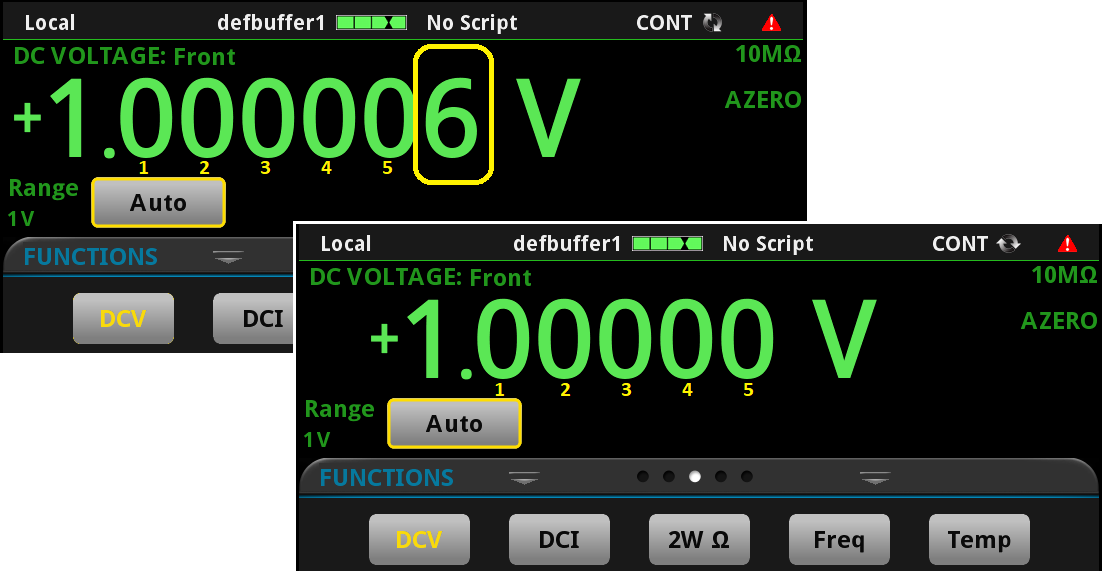
By Josh Brown
Benchtop digital multimeters just love to show off their digits – this is one of the reasons why we value them: they are so giving. But what are all those digits trying to tell us? Let’s take a minute to review what accuracy, resolution, and sensitivity mean for us with respect to a DMM.
Resolution and Sensitivity
You: “Hey, you grouped these two together! Slow down, buddy!”
Me: “Calm down, go to your happy place – I did that for a reason.”
Let’s steal some definitional content from a really cool, intelligent, and free publication called the Low Level Measurements Handbook:
RESOLUTION - the smallest portion of the signal that can be observed.
SENSITIVITY - the smallest change in the signal that can be detected.
Now let’s relate this to what you will find on a 6.5-digit DMM. Let’s say you are measuring a voltage signal on the 1 V range. That first digit is your “half”, so it’ll always be a 1 or a 0. Beyond that, you have the ability to display/observe six additional digits – that last digit will provide you 1 μV of resolution, if you want to see it. Keep in mind that benchtop multimeters typically provide you some control of how many digits are displayed on the front panel, so if you want to see less then you simply adjust the settings to show less.
Sensitivity is a different story because that’s determined by the hardware. If your 6.5-digit DMM specs state that you can detect 1 μV on the 1 V range (and it should) then you can always expect those types of changes to be detected, whether you choose to see them or not. Okay, maybe “always” is a bit extreme – if you push the instrument outside of its comfort zone by measuring faster than the specs prescribe by decreasing the aperture time, then that sensitivity is value is likely derated. (But that’s a topic for another blog entry – more on that later.)
Example:
A 6.5-digit DMM measuring on the 1 V range and programmed to show 6.5 digits exposes the 1 μV sensitivity. You can program the DMM to show just 5.5 digits and that will cover up this sensitivity capability but it still exists.

Accuracy
Accuracy wouldn’t be nearly as interesting if it didn’t come in two flavors. Again, from the Low Level Measurements Handbook:
ABSOLUTE ACCURACY - the closeness of agreement between the result of a measurement and its true value or accepted standard value, taking into account the uncertainty of the standard value.
RELATIVE ACCURACY - the closeness of agreement between the result of a measurement and its true value or accepted standard value but without taking the uncertainty of the standard value into account.
What does this mean? To say your measurements have some amount of “absolute accuracy” means that your measurement will agree with the ideal, perfect, and internationally-accepted-standard within some level – the accuracy specification. This absolute accuracy includes not only uncertainty from your instrument, but also any possible imperfections or errors in the standard that was used to calibrate your instrument in the first place. Absolute accuracy is more practical, similar to saying, “let it be known that there is some uncertainty; it is defined to this degree; and our measurements fall within acceptable limits”.
Relative accuracy takes a more absolutist approach, not accounting for possible error in the “ideal” – if the standard is stating it measures at a certain level, then take it at face value, no questions asked, and if your measurement doesn’t match then it’s wrong. There might be some room for error, but not much. Did your parents ever compare you to one of your siblings they thought could do no wrong? It’s kind of like that.
And, of course, accuracy doesn’t have any bearing on the smallest signal you can see – that’s still the domain of resolution and sensitivity. You can still have sensitivity and resolution without accuracy.
Hope this all makes sense. If nothing else, maybe this post will remind you to call your mom and try to get on her good side, relatively but not absolutely, of course.
Links
Low Level Measurements Handbook, 7th Edition: https://www.tek.com/document/handbook/low-level-measurements-handbook


